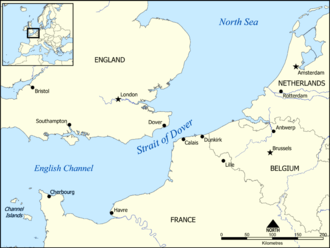| Clearing the Channel Coast | |||||||
|---|---|---|---|---|---|---|---|
| Part of Siegfried Line campaign | |||||||
 The Channel coast | |||||||
| |||||||
| Belligerents | |||||||
| Commanders and leaders | |||||||
| | | ||||||
| Units involved | |||||||
| | | ||||||
| Strength | |||||||
| 2 armoured divisions 4 infantry divisions | 3 divisions (in France) 2 divisions (in Holland) | ||||||
| Casualties and losses | |||||||
| 14,300 casualties | 13,100 killed, wounded, missing 70,971 captured Total: 84,071 casualties | ||||||
Clearing the Channel Coast was a World War II task undertaken by the First Canadian Army in August 1944, following the Allied Operation Overlord and the victory, break-out and pursuit from Normandy.
Contents
- Background
- Normandy to the Seine
- Prelude
- Allied armies
- German
- Advance to the Seine
- Crossing the Seine
- Liberations
- Dieppe
- Le Havre
- Boulogne
- Rocket sites
- Calais and Cap Gris Nez
- Dunkirk
- Belgium
- Scheldt
- Aftermath
- See also
- Footnotes
- References
- Further reading
The Canadian army advanced from Normandy to the Scheldt river in Belgium. En route, they were to capture the Channel ports needed to supply the Allied armies, clear the Germans from the Channel littoral and launch sites for the V-1 flying bombs. The German 15th Army was able only to oppose the advance with sporadic resistance, wary of being outflanked and isolated by the rapidly advancing British Second Army on the right of the Canadians and executed an orderly retreat north-eastwards towards the Scheldt.
On 4 September Adolf Hitler declared the Channel ports to be fortresses but Dieppe and Ostend were taken without opposition. Le Havre, Boulogne and Calais were subjected to set-piece assaults, after massed bombing and an attack on Dunkirk was cancelled and the garrison contained. Troops investing Dunkirk were freed for the Battle of the Scheldt, where the First Canadian Army reduced the Breskens Pocket, cleared the mouth of the Scheldt and opened Antwerp to Allied shipping.

